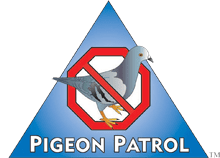
by Pigeon Patrol | Jun 4, 2014 | 4-S Gel Bird repellent, Bird Netting, Pigeons in the News, UltraSonic Bird Control
Sometimes good wine happens by accident or luck. Sometimes it’s inspiration. John Forrest of New Zealand’s Forrest wines has had both.First, the luck. Back in 1996, Forrest noticed that a few rows of grapes were showing signs of bird damage earlier than usual, so he directed his crews to string bird netting along the vines. Not long afterward, the grape clusters developed signs of rot. Forrest realized that the netting had been used the previous year to protect grapes harvested late for his dessert wine, an unctuously sweet Riesling made from grapes shriveled by botrytis — the “noble rot” that, when properly controlled, can concentrate the fruit’s juices and flavors.

Forrest says he could see this technique being useful in hot years when sugar levels could spike in chardonnay or pinot noir. The New Zealand government has funded research on the technique by other growers.
In addition to meeting a perceived market demand for wines with moderate alcohol levels, Forrest says, the technique has the potential to help other wine regions where climate change is affecting vintages.
“You know where this could really make a difference?” he asked me, his eyes wide as grape clusters. “Napa!”
About Pigeon Patrol:
Pigeon Patrol Products & Services is the leading manufacturer and distributor of bird deterrent (control) products in Canada. Pigeon Patrol products have solved pest bird problems in industrial, commercial, and residential settings since 2000, by using safe and humane bird deterrents with only bird and animal friendly solutions. At Pigeon Patrol, we manufacture and offer a variety of bird deterrents, ranging from Ultra-flex Bird Spikes with UV protection, Bird Netting, 4-S Gel and the best Ultrasonic and audible sound devices on the market today.
Voted Best Canadian wholesaler for Bird Deterrent products four years in a row.
Contact Info: 1- 877– 4– NO-BIRD (www.pigeonpatrol.ca)

by Pigeon Patrol | May 4, 2014 | Bird Deterrent Products, Pigeons in the News, UltraSonic Bird Control
 The lethal control of birds is prohibited under the The Wildlife and Countryside Act 1981 unless the species concerned is listed under the relevant section of the Act. Although specific licences are required for some methods of lethal control, such as the use of stupefying baits, the most commonly controlled species of pest birds (such as the feral pigeon) are allowed to be killed under a General Licence. This means that providing an ‘authorised person’ undertakes the culling and providing that the culling is undertaken in accordance with the guidelines laid down by the General Licence, a specific application to kill is not required. All licences are issued and overseen by The Department for Environment, Food and Rural Affairs (DEFRA) including the General Licence.
The lethal control of birds is prohibited under the The Wildlife and Countryside Act 1981 unless the species concerned is listed under the relevant section of the Act. Although specific licences are required for some methods of lethal control, such as the use of stupefying baits, the most commonly controlled species of pest birds (such as the feral pigeon) are allowed to be killed under a General Licence. This means that providing an ‘authorised person’ undertakes the culling and providing that the culling is undertaken in accordance with the guidelines laid down by the General Licence, a specific application to kill is not required. All licences are issued and overseen by The Department for Environment, Food and Rural Affairs (DEFRA) including the General Licence.
Lethal control has been used as a ‘quick-fix’ means of reducing pigeon numbers for as long as there has been a need to control the species. The pest control industry has historically recommended lethal controls alongside the provision of anti-perching and bird exclusion products in an effort to maximise relief for those experiencing pigeon-related problems. Although the installation of anti-perching products (and some bird exclusion products) will resolve a vast majority of pigeon-related problems without the need for additional controls, many pest control companies still recommend lethal control either as a complementary service or as a stand-alone control.
Based on the evidence that culled birds are replaced within a matter of weeks following a cull, culling cannot be used, under any circumstances, to reduce flock size in anything other than the short-term. If a property owner is expected to undertake a cull every few weeks in order to protect his/her property, the cost of the service would be prohibitive. Even in light of these facts, culling is still widely recommended and used by the pest control industry as a method of control. The following methods are commonly used to cull pigeons:
Cage Trap for Killing Pigeons
A suitable area is identified in which to site the trap that is easy to access for the pest control contractor and which is considered to be in an area of high pigeon activity. Other criteria, such as finding a site that is not overlooked, is equally important as the general public find the sight of trapped birds extremely distressing. The cage trap is then baited with pigeon corn for approximately 7 days, allowing pigeons’ free access to enter the trap, feed and then exit the trap. This process is designed to make the birds feel safe whilst feeding within the trap so that after 7 days when the trap is set, the maximum number of birds will be caught. The trap has a two-way door which, when set, allows the pigeon to enter the trap but not to exit it. The trap is then visited once a day and any birds within the trap are removed and either killed on the site or removed live, normally in a sack and taken away to be gassed.
Cage trapping is also highly labour intensive, resulting in higher costs to the client due to the fact that the law states that as a minimum, cage traps must be inspected once every 24 hours. Although the law is quite clear on this point, not all contractors comply with this legislation and empty their traps every 24 hours. If the contractor fails to inspect and empty their traps every 24 hours they run the risk of prosecution, as does the client upon whose site the traps are located. There is also a legal requirement to provide food and water in cage traps but again, not all contractors comply with this aspect of the legislation. 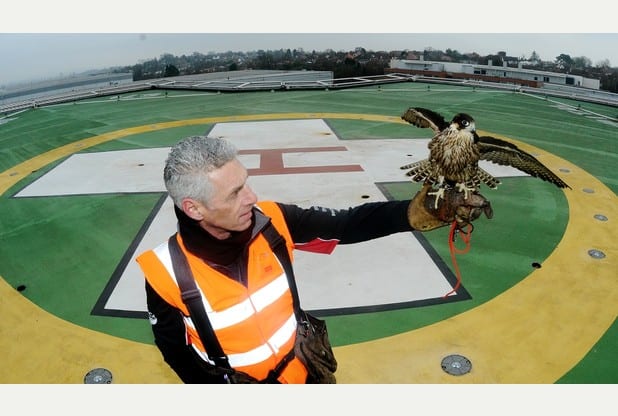
Rifle Used for Killing Pigeons
Shooting operations are normally undertaken at night with daytime shoots only being used in agricultural applications or for specialised urban applications. In urban applications, pigeons are usually shot at night and in their roosting sites because the birds are unable to fly away when the shooting starts, as they would if shoots were undertaken in daylight hours. The major problem inherent with shooting operations is the inability of the shooter to recover and dispatch injured birds. It is virtually impossible to kill a pigeon outright with an air weapon and therefore a majority of birds are simply shot and injured. Because pigeons normally roost at height and because when shot, a pigeon will be pushed backwards with the impact of the pellet entering the body, very few injured pigeons actually fall to the ground. This means that injured birds cannot be dispatched humanely, as is required by law, to prevent suffering taking place, rendering this method of lethal control inhumane. A pigeon can survive for weeks with a pellet lodged in its body and will suffer a slow and lingering death as a result. Also, in situations where a majority of the seriously injured birds cannot be humanely dispatched, the property owner upon who’s site the shooting has taken place will inevitably experience unpleasant smells and maggot infestations as birds die in their roosting places.
About Pigeon Patrol:
Pigeon Patrol Products & Services is the leading manufacturer and distributor of bird deterrent (control) products in Canada. Pigeon Patrol products have solved pest bird problems in industrial, commercial, and residential settings since 2000, by using safe and humane bird deterrents with only bird and animal friendly solutions. At Pigeon Patrol, we manufacture and offer a variety of bird deterrents, ranging from Ultra-flex Bird Spikes with UV protection, Bird Netting, 4-S Gel and the best Ultrasonic and audible sound devices on the market today.
Voted Best Canadian wholesaler for Bird Deterrent products four years in a row.
Contact Info: 1- 877– 4– NO-BIRD (www.pigeonpatrol.ca)
The information on this blog is for personal use only. Content for this blog obtained from other websites is not being used for any commercial reasons whatsoever as per the copyright statement on the Pigeon Control Resource Centre’s website. http://www.pigeoncontrolresourcecentre.org/ Special thanks for the people and companies that helped gather this information. This information is to be used for reference only.
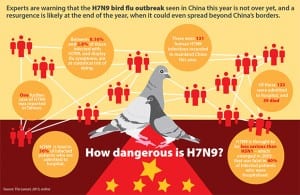
by Pigeon Patrol | May 1, 2014 | 4-S Gel Bird repellent, Animal Deterrent Products, Bird Deterrent Products, Bird Netting, Pigeon Spikes, UltraSonic Bird Control
 More than 60 transmissible diseases (some of which are fatal) are associated with geese, pigeons, starlings and house sparrows. For example:
More than 60 transmissible diseases (some of which are fatal) are associated with geese, pigeons, starlings and house sparrows. For example:
Histoplasmosis is a respiratory disease that may be fatal. It results from a fungus growing in dried bird droppings.
Candidiasis is a yeast or fungus infection spread by pigeons. The disease affects the skin, the mouth, the respiratory system, the intestines and the urogenital tract, especially the vagina. It is a growing problem for women, causing itching, pain and discharge.
Cryptococcosis is caused by yeast found in the intestinal tract of pigeons and starlings. The illness often begins as a pulmonary disease and may later affect the central nervous system. Since attics, cupolas, ledges, schools, offices, warehouses, mills, barns, park buildings, signs, etc. are typical roosting and nesting sites, the fungus is apt to found in these areas.
St. Louis Encephalitis, an inflammation of the nervous system, usually causes drowsiness, headache and fever. It may even result in paralysis, coma or death. St. Louis encephalitis occurs in all age groups, but is especially fatal to persons over age 60. The disease is spread by mosquitoes which have fed on infected house sparrow, pigeons and house finches carrying the Group B virus responsible for St. Louis encephalitis.
Salmonellosis often occurs as “food poisoning” and can be traced to pigeons, starlings and sparrows. The disease bacteria are found in bird droppings; dust from droppings can be sucked through ventilators and air conditioners, contaminating food and cooking surfaces in restaurants, homes and food processing plants.
Besides being direct carriers of disease, nuisance birds are frequently associated with over 50 kinds of ectoparasites, which can work their way throughout structures to infest and bite humans. About two-thirds of these pests may be detrimental to the general health and well-being of humans and domestic animals. The rest are considered nuisance or incidental pests. A few examples of ectoparasites include:
Chicken mites (Dermanyssus gallinae) are known carriers of encephalitis and may also cause fowl mite dermatitis and acariasis. While they subsist on blood drawn from a variety of birds, they may also attack humans. They have been found on pigeons, starlings and house sparrows.
Yellow mealworms (Tenebrio molitor), perhaps the most common beetle parasites of people in the United States, live in pigeon nests. It is found in grain or grain products, often winding up in breakfast cereals, and may cause intestinal canthariasis and hymenolespiasis.
West Nile Virus while West Nile is technically not transmitted to humans from birds, humans can get infected by the bite of a mosquito who has bitten an infected bird. The obvious lesson is that the fewer birds there are in any given area, the better. This translates into a smaller chance of an infected bird in that area, a smaller chance of a mosquito biting an infected bird and then biting a human.
About Pigeon Patrol:
Pigeon Patrol Products & Services is the leading manufacturer and distributor of bird deterrent (control) products in Canada. Pigeon Patrol products have solved pest bird problems in industrial, commercial, and residential settings since 2000, by using safe and humane bird deterrents with only bird and animal friendly solutions. At Pigeon Patrol, we manufacture and offer a variety of bird deterrents, ranging from Ultra-flex Bird Spikes with UV protection, Bird Netting, 4-S Gel and the best Ultrasonic and audible sound devices on the market today.
Voted Best Canadian wholesaler for Bird Deterrent products four years in a row.
Contact Info: 1- 877– 4– NO-BIRD (www.pigeonpatrol.ca)
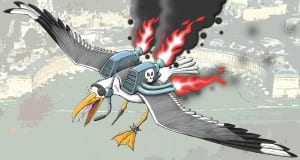
by Pigeon Patrol | Apr 7, 2014 | Bird Deterrent Products, Bird Netting, Pigeon Spikes, Pigeons in the News, UltraSonic Bird Control
 OTTAWA — An Ottawa man will serve five days in jail for bashing a gull to death because it was stealing the seed he meant for pigeons in the ByWard Market last summer.
OTTAWA — An Ottawa man will serve five days in jail for bashing a gull to death because it was stealing the seed he meant for pigeons in the ByWard Market last summer.
Keith Watt, 59, was sentenced Thursday in an Ottawa courtroom on a charge of causing distress to an animal.
Watt beat the bird on Aug. 27, 2013. It died of its injuries two days later.
“Violence against animals is not acceptable, no matter what the animal,” Bruce Roney, executive director of the Ottawa Humane Society, said in a statement. “This bird really suffered before dying from its injuries. We’re pleased the justice system has acknowledged that this act of animal cruelty is unacceptable to our community.”
According the Humane Society report of the case, Watt was feeding pigeons in the Market and got mad when gulls arrived and began to eat the food, too. One gull got close enough that Watt was able to grab it. The gull bit him.
Watt “responded by swinging the gull with what appeared to be full force against a brick wall.” He then tossed the badly injured bird over a nearby fence.
A witness reported the incident and the gull was taken to the Wild Bird Care Centre, where it died.
Watt was charged under the Ontario SPCA Act.
He was also put on probation for two years and is banned from owning an animal for five years. He must also pay the Humane Society’s court costs.
About Pigeon Patrol:
Pigeon Patrol Products & Services is the leading manufacturer and distributor of bird deterrent (control) products in Canada. Pigeon Patrol products have solved pest bird problems in industrial, commercial, and residential settings since 2000, by using safe and humane bird deterrents with only bird and animal friendly solutions. At Pigeon Patrol, we manufacture and offer a variety of bird deterrents, ranging from Ultra-flex Bird Spikes with UV protection, Bird Netting, 4-S Gel and the best Ultrasonic and audible sound devices on the market today.
Voted Best Canadian wholesaler for Bird Deterrent products four years in a row.
Contact Info: 1- 877– 4– NO-BIRD (www.pigeonpatrol.ca) Now shipping World Wide.
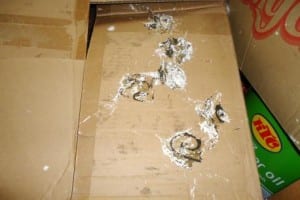
by Pigeon Patrol | Apr 7, 2014 | Bird Deterrent Products, Bird Netting, Pigeon Patrol's Services, Pigeon Spikes, Pigeons in the News
 A TONNE of food must be destroyed — because it was being packaged in a warehouse infested with pigeons.
A TONNE of food must be destroyed — because it was being packaged in a warehouse infested with pigeons.
Bolton Council applied for a food condemnation order at Bolton Magistrates Court after environmental health officials found the food and packaging belonging to Barkat Food Store Bolton Ltd covered with pigeon droppings, which they said caused “substantial contamination of food”.
Catherine Waudby, on behalf of Bolton Council, told District Judge James Prowse that the contamination, which is a danger to public health, had come to light on March 5 during a routine environmental health inspection at a warehouse The premises were supposed to be used for storage, but inspectors found Asian dried foodstuffs, such as rice, popcorn, nuts and spices, being packaged there, with droppings on the food and plastic wrappings and no hand washing facilities available.
The tonne of food was seized and yesterday (TUE), at Bolton Magistrates Court, the judge ordered it be dyed and disposed of in bins.
A Bolton Council spokesman said: “We take breaches of food hygiene very seriously and take prompt and decisive action to protect consumers whose health could be put at risk.
About Pigeon Patrol:
Pigeon Patrol Products & Services is the leading manufacturer and distributor of bird deterrent (control) products in Canada. Pigeon Patrol products have solved pest bird problems in industrial, commercial, and residential settings since 2000, by using safe and humane bird deterrents with only bird and animal friendly solutions. At Pigeon Patrol, we manufacture and offer a variety of bird deterrents, ranging from Ultra-flex Bird Spikes with UV protection, Bird Netting, 4-S Gel and the best Ultrasonic and audible sound devices on the market today.
Voted Best Canadian wholesaler for Bird Deterrent products four years in a row.
Contact Info: 1- 877– 4– NO-BIRD (www.pigeonpatrol.ca) Now shipping World Wide.

